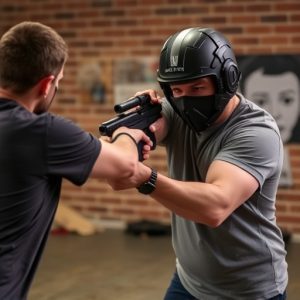Stun Gun Effectiveness: Duration & Safety for College Self-Defense
For college students seeking self-defense, understanding the duration of muscle incapacitation from…….
For college students seeking self-defense, understanding the duration of muscle incapacitation from stun guns is crucial. While initial shock disrupts nerve impulses for 3-5 seconds, the goal is to keep attackers incapacitated until help arrives. Higher joule ratings provide longer durations, and targeting pressure points maximizes efficacy. However, legal complexities and safety considerations, including varying state laws and potential body type/gear impacts, necessitate responsible use and consultation with authorities before carrying self-defense stun guns on campuses.
“Uncovering the impact of stun guns on muscle incapacitation is crucial, especially for self-defense tools like those favored by college students. This article explores the duration and effects of muscle paralysis induced by stun guns, offering insights into their efficacy as personal defense mechanisms. We delve into the science behind muscle incapacitation, examine factors influencing stun gun performance, and discuss legal aspects alongside safety tips for responsible carrying. For self-defense stun guns on campus, understanding these elements is key to informed decision-making.”
- Understanding Muscle Incapacitation: How Long Does It Last?
- Self-Defense Stun Guns: A Tool for College Students
- Factors Affecting Stun Gun Efficacy and Duration
- Legal Considerations and Safety Tips for Carrying Stun Guns
Understanding Muscle Incapacitation: How Long Does It Last?
Understanding Muscle Incapacitation: How Long Does It Last?
When considering self-defense stun guns for college students, understanding muscle incapacitation duration is crucial. The effect of a stun gun on an assailant aims to disrupt their motor functions by delivering an electrical current that interferes with nerve impulses to muscles. This temporary paralysis can last anywhere from 3 to 5 seconds, providing the user with precious time to escape or seek help. However, it’s important to note that the duration can vary based on factors such as the stun gun’s output level, the assailant’s body type, and the specific nerve targets affected.
For college students looking into self-defense options, this brief window of incapacitation is significant. It allows them to disable an attacker long enough to get away or call for assistance. However, it’s a misconception to rely solely on the initial shock for safety. The primary goal should be to ensure the assailant remains incapacitated until help arrives, often requiring follow-up actions like applying pressure to any wounds caused by the stun gun or using other self-defense tools if needed.
Self-Defense Stun Guns: A Tool for College Students
Self-defense stun guns have emerged as a popular tool among college students seeking to protect themselves in an increasingly uncertain world. These compact and easy-to-use devices offer a non-lethal way to incapacitate an attacker, providing valuable time for escape or assistance. In the fast-paced and often unpredictable environment of campus life, where students may be far from home and familiar surroundings, having a stun gun can instill a sense of security and empowerment.
For college students, self-defense stun guns represent a viable option due to their discreet size and effectiveness. They are designed to deliver a powerful electric shock, temporarily paralyzing the target without causing serious harm. This allows users to disable an aggressor long enough to get away or alert authorities, making them valuable tools for personal safety on campus. With proper training and understanding of their capabilities, students can confidently carry and use these devices as part of their overall safety strategy.
Factors Affecting Stun Gun Efficacy and Duration
The effectiveness and duration of muscle incapacitation from self-defense stun guns can vary significantly based on several factors. One key factor is the power output of the device, measured in joules. Higher-wattage stun guns typically deliver more electrical current, resulting in longer durations of muscle paralysis. This is particularly important for college students considering self-defense options, as a more powerful stun gun can provide additional time to escape or seek help during an encounter.
Another critical aspect is the target area of application. Stun guns are most effective when applied directly to pressure points or nerve centers like the wrists, ankles, or neck. Proper placement ensures maximum electrical current flow, leading to quicker and longer-lasting incapacitation. However, factors such as the user’s proficiency in applying the device, the subject’s body type, and any resistance or protective gear they might be wearing can also influence the overall efficacy and duration of muscle incapacitation.
Legal Considerations and Safety Tips for Carrying Stun Guns
Carrying a self-defense stun gun, especially on college campuses, raises important legal considerations and safety concerns. It’s crucial to understand that regulations surrounding stun guns vary significantly from state to state, with some areas permitting their use only for law enforcement or personal protection under specific circumstances. For instance, many colleges have strict policies regarding the possession of any kind of weapon on campus, including stun guns, even if they are used for self-defense.
Students considering carrying a stun gun for protection should prioritize safety above all else. This includes familiarizing themselves with local laws and campus policies, ensuring they purchase a reliable device from reputable sources, and learning proper usage techniques. Additionally, being aware of their surroundings and avoiding potentially dangerous situations can significantly reduce the need to use a stun gun. Always consult with relevant authorities and legal experts before making the decision to carry self-defense stun guns on college campuses.
In conclusion, self-defense stun guns can be a valuable tool for college students looking to protect themselves in potentially dangerous situations. Understanding the duration of muscle incapacitation from these devices is crucial for effective use and safety. Factors like the stun gun’s power, distance, and contact points influence its effectiveness, while legal considerations and proper handling practices ensure responsible carrying. By staying informed about these aspects, college students can make informed decisions regarding self-defense stun guns as a means of personal safety on campus.


